Blood vessels travel - Study guides, Class notes & Summaries
Looking for the best study guides, study notes and summaries about Blood vessels travel? On this page you'll find 2136 study documents about Blood vessels travel.
Page 4 out of 2.136 results
Sort by
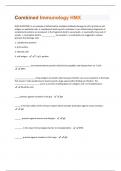
-
Combined Immunology HMX Questions And Answers.
- Exam (elaborations) • 133 pages • 2024
- Available in package deal
-
- $7.99
- + learn more
QUIZ QUESTION: In an example of inflammation-mediated antibody damage to cells, Ig binds to self antigen on epithelial cells → complement binds Ig and is activated → pro inflammatory fragments of complement proteins are produced → the fragments bind to vessel walls → neutrophils move out of vessels → neutrophils bind to ____________ via receptors → neutrophils are triggered to release granules that damage cells. 1. complement proteins 2. Ig Fc portion 3. infected cells 4. sel...
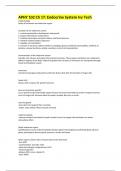
-
APHY 102 Ch 17: Endocrine System Ivy Tech
- Exam (elaborations) • 11 pages • 2024
-
Available in package deal
-
- $9.69
- + learn more
APHY 102 Ch 17: Endocrine System Ivy Tech endocrinology Study of hormones and endocrine organs functions of the endocrine system 1. control reproduction, development and growth 2. prepare the body to combat stress 3. maintain electrolyte and water balance and blood pressure 4. maintain nutrient balance (glucose) 5. regulate cell metabolism 6. increase or decrease cellular activity by changing: plasma membrane permeability, synthesis of proteins, enzyme functions, cellular secretions...
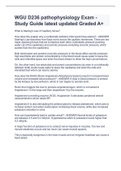
-
WGU D236 pathophysiology Exam -Study Guide latest updated Graded A+
- Exam (elaborations) • 32 pages • 2022
-
- $12.99
- 2x sold
- + learn more
What is Starling's Law of Capillary forces? How does this explain why a nutritionally deficient child would have edema? - ANSWER Starling's Law describes how fluids move across the capillary membrane. There are two major opposing forces that act to balance each other, hydrostatic pressure (pushing water out of the capillaries) and osmotic pressure (including oncontic pressure, which pushes fluid into the capillaries). Both electrolytes and proteins (oncontic pressure) in the blood affe...
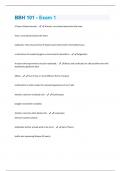
-
BBH 101 - Exam 1 questions and answers 100% verified
- Exam (elaborations) • 19 pages • 2024
- Available in package deal
-
- $7.99
- + learn more
3 Types of blood vessels: - Arteries: carry blood away from the heart Veins: carry blood towards the heart Capillaries: Very tiny branches of blood vessels that branch into bodily tissues a mechanism for explaining gene x environment interactions - Epigenetics A reason why experiments must be replicated: - Biases and confounds are still possible even with statistically significant data Alleles - one of two or more different forms of a gene combination is what creates the outward appearanc...
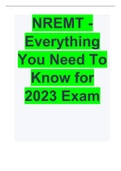
-
NREMT - Everything You Need To Know for 2023 Exam
- Exam (elaborations) • 29 pages • 2023
-
Available in package deal
-
- $15.49
- 1x sold
- + learn more
NREMT - Everything You Need To Know for 2023 Exam Medical Direction – Oversight of the patient-care aspects of an EMS system by the Medical Director. Protocols – lists of steps, such as assessments and interventions, to be taken in different situations. Protocols are developed by the Medical Director of an EMS system Offline Direction – consists of standing orders issued by the medical director that allows EMTs to give certain medications or perform certain proce...
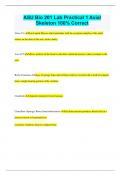
-
ASU Bio 201 Lab Practical 1 Axial Skeleton 100% Correct
- Exam (elaborations) • 12 pages • 2024
- Available in package deal
-
- $8.99
- + learn more
ASU Bio 201 Lab Practical 1 Axial Skeleton 100% Correct Atlas (C1) has Lateral Masses which articulate with the occipital condyles of the skull; rotates on the dens of the axis; lacks a body. Axis (C2) allows rotation of the head via the dens (odontoid process); dens is unique to the axis. Body (Centrum) mass of spongy bone and red bone marrow covered with a shell of compact bone; weight-bearing portion of the vertebra. Canaliculi channels running between lacunae. Cancellous...
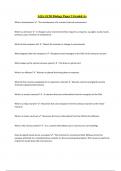
-
AQA GCSE Biology Paper 2 Graded A+
- Exam (elaborations) • 34 pages • 2024
-
Available in package deal
-
- $9.99
- + learn more
AQA GCSE Biology Paper 2 Graded A+ What is homeostasis? ️The maintenance of a constant internal environment. What is a stimulus? ️A change in your environment than requires a response. e.g Light, sound, touch, pressure, pain, chemical or temperature. What do the receptors do? ️Detect the stimulus or change in environment. What happens after the receptors? ️Receptors send messages to the CNS via the sensory neurone. What makes up the central nervous system? ️The brain or spi...
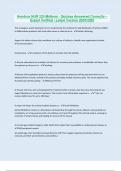
-
Hondros NUR 220 Midterm / Quizzes Answered Correctly – Expert Verified | Latest Version 2024/2025
- Exam (elaborations) • 11 pages • 2024
- Available in package deal
-
- $10.49
- + learn more
The strategy to avoid medication errors endorsed by the Institute for Safe Medication Practices (ISMP) to differentiate products with look-alike names is referred to as - tallman lettering Aspects of safety culture that contribute to a culture of safety in a health care organization include - communication Homeostasis - a tendency of the body to maintain internal stability A 49-year-old patient has multiple risk factors for coronary artery disease. A modifiable risk factor that the patient...
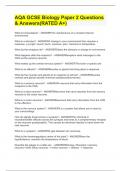
-
AQA GCSE Biology Paper 2 Questions & Answers(RATED A+)
- Exam (elaborations) • 24 pages • 2024
-
Available in package deal
-
- $12.99
- + learn more
What is homeostasis? - ANSWERThe maintenance of a constant internal environment. What is a stimulus? - ANSWERA change in your environment than requires a response. e.g Light, sound, touch, pressure, pain, chemical or temperature. What do the receptors do? - ANSWERDetect the stimulus or change in environment. What happens after the receptors? - ANSWERReceptors send messages to the CNS via the sensory neurone. What makes up the central nervous system? - ANSWERThe brain or spinal cord ...
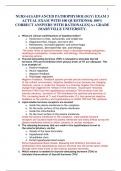
-
2023/2024 NURS 611(ADVANCED PATHOPHYSIOLOGY) EXAM 3 ACTUAL EXAM WITH 100 QUESTIONS& 100% CORRECT ANSWERS WITH RATIONALES| A+ GRADE (MARYVILLE UNIVERSITY)
- Exam (elaborations) • 33 pages • 2023
-
Available in package deal
-
- $18.49
- + learn more
2023/2024 NURS 611(ADVANCED PATHOPHYSIOLOGY) EXAM 3 ACTUAL EXAM WITH 100 QUESTIONS& 100% CORRECT ANSWERS WITH RATIONALES| A+ GRADE (MARYVILLE UNIVERSITY) 1. What are clinical manifestations of hypothyroidism? a. Intolerance to heat, tachycardia, and weight loss b. Oligomenorrhea, fatigue, and warm skin c. Restlessness, increased appetite, and metrorrhagia d. Constipation, decreased heat rate, and lethargy The lower levels of thyroid hormone result in decreased energy metabolism, resultin...

Study stress? For sellers on Stuvia, these are actually golden times. KA-CHING! Earn from your study resources too and start uploading now. Discover all about earning on Stuvia


